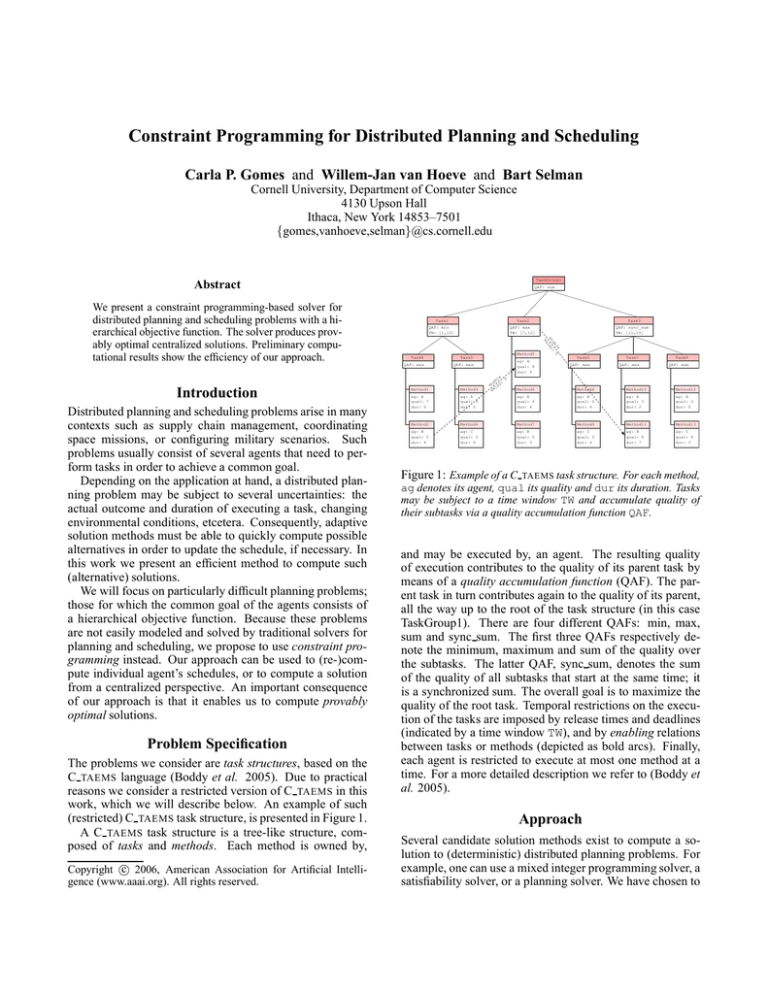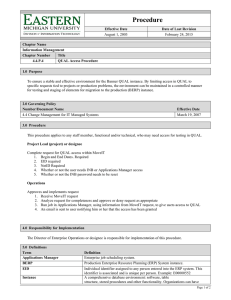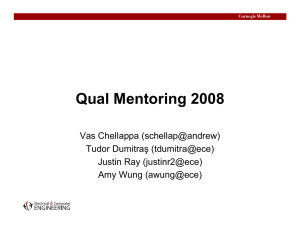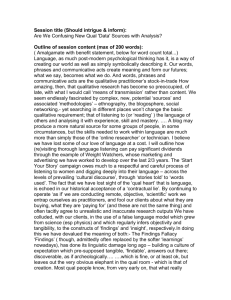
Constraint Programming for Distributed Planning and Scheduling
Carla P. Gomes and Willem-Jan van Hoeve and Bart Selman
Cornell University, Department of Computer Science
4130 Upson Hall
Ithaca, New York 14853–7501
{gomes,vanhoeve,selman}@cs.cornell.edu
TaskGroup1
Abstract
Introduction
Distributed planning and scheduling problems arise in many
contexts such as supply chain management, coordinating
space missions, or configuring military scenarios. Such
problems usually consist of several agents that need to perform tasks in order to achieve a common goal.
Depending on the application at hand, a distributed planning problem may be subject to several uncertainties: the
actual outcome and duration of executing a task, changing
environmental conditions, etcetera. Consequently, adaptive
solution methods must be able to quickly compute possible
alternatives in order to update the schedule, if necessary. In
this work we present an efficient method to compute such
(alternative) solutions.
We will focus on particularly difficult planning problems;
those for which the common goal of the agents consists of
a hierarchical objective function. Because these problems
are not easily modeled and solved by traditional solvers for
planning and scheduling, we propose to use constraint programming instead. Our approach can be used to (re-)compute individual agent’s schedules, or to compute a solution
from a centralized perspective. An important consequence
of our approach is that it enables us to compute provably
optimal solutions.
Problem Specification
The problems we consider are task structures, based on the
C TAEMS language (Boddy et al. 2005). Due to practical
reasons we consider a restricted version of C TAEMS in this
work, which we will describe below. An example of such
(restricted) C TAEMS task structure, is presented in Figure 1.
A C TAEMS task structure is a tree-like structure, composed of tasks and methods. Each method is owned by,
c 2006, American Association for Artificial IntelliCopyright gence (www.aaai.org). All rights reserved.
Task1
Task2
QAF: min
TW: [1,10]
QAF: max
TW: [7,12]
Method5
Task4
Task5
QAF: max
QAF: max
ag: A
qual: 8
dur: 6
le 0
ab :
en lay
de
Task3
QAF: sync_sum
TW: [11,19]
le 0
ab :
en lay
de
We present a constraint programming-based solver for
distributed planning and scheduling problems with a hierarchical objective function. The solver produces provably optimal centralized solutions. Preliminary computational results show the efficiency of our approach.
QAF: sum
Task6
Task7
Task8
QAF: max
QAF: max
QAF: max
Method1
Method3
Method6
Method8
Method10
Method12
ag: A
qual: 7
dur: 6
ag: A
qual: 6
dur: 6
ag: B
qual: 6
dur: 4
ag: B
qual: 6
dur: 4
ag: A
qual: 3
dur: 2
ag: A
qual: 9
dur: 8
Method2
Method4
Method7
Method9
Method11
Method13
ag: B
qual: 5
dur: 4
ag: C
qual: 5
dur: 4
ag: B
qual: 5
dur: 3
ag: C
qual: 6
dur: 4
ag: B
qual: 8
dur: 7
ag: C
qual: 4
dur: 3
Figure 1: Example of a C TAEMS task structure. For each method,
ag denotes its agent, qual its quality and dur its duration. Tasks
may be subject to a time window TW and accumulate quality of
their subtasks via a quality accumulation function QAF.
and may be executed by, an agent. The resulting quality
of execution contributes to the quality of its parent task by
means of a quality accumulation function (QAF). The parent task in turn contributes again to the quality of its parent,
all the way up to the root of the task structure (in this case
TaskGroup1). There are four different QAFs: min, max,
sum and sync sum. The first three QAFs respectively denote the minimum, maximum and sum of the quality over
the subtasks. The latter QAF, sync sum, denotes the sum
of the quality of all subtasks that start at the same time; it
is a synchronized sum. The overall goal is to maximize the
quality of the root task. Temporal restrictions on the execution of the tasks are imposed by release times and deadlines
(indicated by a time window TW), and by enabling relations
between tasks or methods (depicted as bold arcs). Finally,
each agent is restricted to execute at most one method at a
time. For a more detailed description we refer to (Boddy et
al. 2005).
Approach
Several candidate solution methods exist to compute a solution to (deterministic) distributed planning problems. For
example, one can use a mixed integer programming solver, a
satisfiability solver, or a planning solver. We have chosen to
use constraint programming (CP) for the following reasons.
The most important reason is that constraint programming
has a rich modeling language which is very convenient to
express the problem. Moreover, the underlying CP solver
is relatively robust with respect to the addition of new constraints, and the search can be controlled entirely by the user.
In contrast, although the problem can be modeled to fit a
mixed integer programming or satisfiability solver, we expect the respective solvers to suffer from the time granularity of the problem. This is not the case with a CP model.
Finally, most planning solvers do not offer an easy way to
model more complex objective functions.
We next give a brief overview of the core of our CP model.
The key variables of our model are the variables that control the execution of the methods. They are represented
by a variable methodi for every task i that has methods as
its leafs. The domain of this variable is given by its leafs
(methods) and the no-execute option (denoted by method
0).1 Hence, if methodi = j, then task i is executed using
method j. To infer the agent, quality and duration of task
i, we use so-called “element” constraints. Let the agent,
quality and duration of a respective method j of task i be
given by ttag[i][j], qual[i][j] and dur[i][j]. We introduce
variables agenti , qualityi and durationi and impose the
constraints:
Table 1 presents computational results on a number of test
problems. As constraint programming solver we have used
ILOG Solver, version 6.0. The experiments were performed
on a Pentium III 550MHz, 4GB RAM, with a time limit of
300 seconds per instance.
agenti = ag[i][methodi ],
qualityi = qual[i][methodi ],
durationi = dur[i][methodi ].
Table 1: Computational results on a number of C TAEMS task
structures. All instances are solved to optimality, unless the time
limit (300s) has been reached. Here ‘problem’ denotes the name
of the instance, ‘#tasks’, ‘#methods’ and ‘#enables’ denote respectively the number of tasks, methods and enabling relations of the
instance, ‘optimum’ denotes the optimal quality found, or the best
solution found in case the time limit is reached, and ‘time’ denotes
the total solution time in seconds.
For the temporal relations we introduce variables starti
and endi for each task i to indicate its start and end time.
Then the release time and deadline constraints are easily
modeled. The ‘enabling’ relationships need a bit more care,
as they depend on the activation time of the task, i.e. the first
moment it receives positive quality.
Although the above description is very brief, it reflects the
core of our CP model. In fact, the search space is only defined by the variables method and start. By constraint
propagation, all other variables are instantiated automatically once these variables are set.
Computational Results
As a case study we use problem instances from the COORDINATORs project, which are available from the authors on
request. The instances represent real-life problem instances
of medium to large size. The instances are typically designed for a dynamic multi-agent environment. It means
that for most methods, the duration time and the quality are
drawn from outcome distributions rather than being single
values. Moreover, certain methods have a chance of failure.
In our experiments we have replaced the outcome distributions by expected quality and maximum duration to make
the problem deterministic. We further neglect methods that
have a chance of failure. Our model can be easily adapted
however, to change these settings.
1
For simplicity we assume that each such task can execute at
most one method. Task structures can be transformed to meet this
assumption, however.
instance
CExample3 min
CExample3 max
CExample3 sum
ten1
test1a
test1
test2
test3
test4
testa
testb
testc
sgp-50920-213447
sgp-50920-213845
sgp-50920-214347
sgp-50920-214707
sgp-50920-214737
sgp-50920-214829
sgp-50920-214847
sgp-50920-215026
sgp-50920-215507
sgp-50920-215553
sgp-50920-221059
sgp-50920-221139
#tasks
16
16
16
116
21
21
30
85
104
21
21
21
23
63
23
29
36
40
48
23
26
26
38
53
#methods
43
43
43
160
42
42
21
288
89
56
42
70
28
144
56
60
81
90
152
28
48
80
112
160
#enables
5
5
5
21
5
5
15
11
25
5
5
5
4
82
5
8
15
20
32
6
11
13
10
10
optimum
20
60
138
≥31.6
33
37
45.8
≥74.4
95.4
36.8
36
33.6
20
≥30
18
28
30
40
40
20
13.6
10
32
36
time (s)
0.02
0.05
0.08
limit
0.02
0.07
0.03
limit
0.44
0.03
0.04
0.06
0.02
limit
0.04
0.04
0.05
0.07
0.09
0.02
0.09
0.06
0.13
0.09
Although most instances are solved very quickly, some
instances were not solved to optimality within 300 seconds.
This is probably due to the large number of methods present
in these instances. As a result, the domains of the method
variables are also large, which typically has a negative effect
on the performance of a CP solver. On the other hand, some
other instances with large domains are solved very quickly,
which motivates the need for a closer investigation of the
hardness profile of these problems.
Conclusion and Future Perspectives
We have shown that constraint programming can be a very
efficient tool to model and solve distributed planning and
scheduling problems with a hierarchical objective function.
As our approach produces provably optimal (centralized) solutions, it will be particularly useful to evaluate the performance of problem-specific decentralized solvers. Furthermore, we intend to investigate the hardness profile of these
problems in more detail, for which an efficient solver is indispensable.
References
Boddy, M.; Horling, B.; Phelps, J.; Goldman, R.; Vincent,
R.; Long, A.; and Kohout, B. 2005. C TAEMS Language
Specification — Version 1.03.






